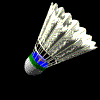 Back To Badminton Page
Back To Badminton Page Back to Homepage
Back to Homepage

Well the idea of badminton is very simple. But the rules of badminton are a lot more complex and difficult to understand. I will first give the basic idea of badminton, then I will list the rules just as they appear in the official rulebook. Also later I will add a part on this page for tips on playing badminton that I have picked up over time. And I will add graphics on the size of the court and other things once I get access to a scanner. But until then you got these great text rules. Ok everybody? Good, lets get to it.

You and you opponent take your positions on opposite sides of the net. Im not going to tell you the dimentions of the court, Im assuming you already have a court to play on. Hopefully you each have a racket and at least one birdie. To decide who serves first hit the birdie high into the air, when it hits the ground the person it is pointing at gets to serve first. There are other ways to decide who serves first such as Greco-Roman wrestling but this is probably the best. Whoever gets to serve first stands in the box on the right side of the court behind that line that is located about 2 feet from the net. (It's called the short service line if you must know). Your opponent stands on his/her right side of the court. The server hits the birdie underhanded so that contact between the birdie and the racket take place under the servers waist. The server hits the birdie into the side of the court diagnol from him, into the court where his opponent is standing.
Now you see that there are 2 different lines in the back and 2 different lines on the sides of the court. Here are what we will call the lines.

Doubles is pretty much just the same as singles except for a few minor changes. In doubles the service lines are short and wide. Normal play lines are long and wide. The first team that serves starts on the right side of the court and serves across. After they lose that serve it goes to the other teams player that is standing on the right side. After he loses that serve his partner gets to serve. After that it goes to the other side and does the same thing until the end.
There are many different ways you can score. Here is a list of all the different things that can happen to either cause you to score a point (when serving), or get a side out (when not serving). These go the same for when you do these things your opponent scores. Thatspretty much it, there are a few other things that are different, bt they wil be outlied in the scori section.
 Back To Badminton Page
Back To Badminton Page Back to Homepage
Back to Homepage